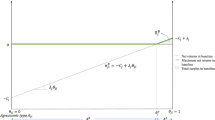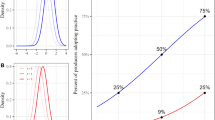Abstract
The objectives of this study are to develop and test a framework to estimate the cost of enhancing agriculture’s potential as a carbon sink through the implementation of reduced tillage productive systems. A major factor inhibiting the adoption of reduced tillage practices is the additional risk perceived by farmers and its effect on net revenues. The expected utility model provides a useful means for evaluating risk–return tradeoffs of agricultural production systems. Incentive levels required to induce implementation of reduced tillage practices are calculated using estimated certainty equivalents. The framework developed is applied to eight case studies across the United States. Results indicate that in the Corn Belt, the required incentive payment for corn/soybeans would have to be $10.20 and $8.30 per acre for poorly drained and well-drained soils, respectively. Continuous corn incentive payments for poorly drained soils were found to be $40.40 and $26.70 for well-drained soils. In the central Great Plains, an incentive level of $14.60 per acre was required for continuous sorghum. Although the mean yields for conventional and reduced tillage practices are fairly close in this case, the higher costs associated with no-till sorghum result in the high incentive level. In the wheat/fallow and wheat/sorghum/fallow rotations of the western Great Plains, the yields associated with no-till were higher than intensive till. Thus, incentive levels near $6.00 per acre are the result of higher costs of no-till in these rotations. In the Mississippi River Corridor region, results show that the switch from corn/soybean to the same no-till rotation would require an incentive level of $7.90 per acre.



Similar content being viewed by others
References
D. M. Adams R. J. Alig B. A. McCarl J. M. Callaway S. M. Winnett (1999) ArticleTitleMinimum cost strategies for sequestering carbon in forests. Land Economics 75 360–374
R. M. Adams C. C. Chang B. A. McCarl J. M. Callaway (1992) The role of agriculture in climate change: A preliminary evaluation of emission control strategies. J. M. Reilly M. Anderson (Eds) Economics issues in global climate change: agriculture, forestry, and natural resources. Westview Press Boulder, Colorado 273–287
American Agricultural Economics Association (AAEA). 1998. Commodity costs and returns estimation handbook: A report of the AAEA task force on commodity costs and returns. AAEA, Ames, Iowa
Bradley, J. F. 1995. Success with no-till cotton in Arkansas. Pages 46–48 in Agricultural Experiment Station special publication 160, University of Arkansas
H. J. Brown (1989) ArticleTitleTillage system effects on crop growth and production costs for a corn–soybean rotation. Journal of Production Agriculture 2 273–279
Cochran, M. J. 1986. Stochastic dominance: The state of the art in agricultural economics. In Southern Regional Project S-180 Seminar Proceedings. Department of Agricultural Economics, Washington State University
C. E. Dickey P. Jasa R. Grisso (1994) ArticleTitleLong term tillage effects on grain yield and soil properties in a soybean/grain sorghum rotation. Journal of Production Agriculture 7 465–470
J. H. Edwards D. L. Thurlow J. T. Eason (1988) ArticleTitleInfluence of tillage and crop rotation on yields of corn, soybean, and wheat. Agronomy Journal 80 76–80
R. J. Freund (1956) ArticleTitleIntroduction of risk into a programming model. Econometrica 24 257–263
P. Kauppi R. Sedjo (2001) Technological and economic potential of options to enhance, maintain, and manage biological carbon reservoirs and geo-engineering. . . (Eds) Climate change 2001: Mitigation. Cambridge University Press New York 303–341
Kurkalova, L., C. Kling, and J. Zhao. 2001. The subsidy for adopting conservation tillage: Estimation from observed behavior. Working Paper 01-WP 286, Center for Agricultural and Rural Development, Iowa State University
R. Lal J. M. Kimble R. F. Follett C. V. Cole (1999) U.S. cropland’s overall potential to mitigate the greenhouse effect. R Lal J. M. Kimble R. F. Follett C. V. Cole (Eds) The potential of U.S. cropland to sequester carbon and mitigate the greenhouse effect. Lewis Publishers Washington, DC 81–87
Lamond, R. E., G. M. Pierzynski, and D. A. Whitney, 2002. Long-term nitrogen management and tillage effects on grain sorghum. Working Paper. Department of Agronomy, Kansas State University
J. A. Larson R. K. Roberts D. D. Tyler B. N. Duck S. P. Slinsky (1998) ArticleTitleNitrogen fixing winter cover crops and production risk: A case study for no tillage corn. Journal of Agricultural and Applied Economics 30 163–174
J. A. Larson E. C. Jaenicke R. K. Roberts D. D. Tyler (2001) ArticleTitleRisk effects of alternative winter cover crop, tillage, and nitrogen fertilization systems in cotton production. Journal of Agricultural and Applied Economics 33 445–457
B. A. McCarl (2001) ArticleTitleGreenhouse gas mitigation in U.S. agriculture and forestry. Science 294 2481–2482 Occurrence Handle10.1126/science.1064193 Occurrence Handle1:CAS:528:DC%2BD38XntFem Occurrence Handle11752558
B. A. McCarl U. Schneider (2000) ArticleTitleU.S. agriculture’s role in a greenhouse gas emission mitigation world: An economic perspective. Review of Agricultural Economics 22 134–159 Occurrence Handle10.1111/1058-7195.t01-1-00011
J. Meyer (2002) Expected utility model as a paradigm for decision making in agriculture. R. E. Just R. Pope (Eds) The role of risk in agriculture. Kluwer Academic Publishers Norwell, Massachusetts 3–20
C. A. Norwood A. J. Schlegel D. W. Morishita R. E. Gwin (1990) ArticleTitleCropping system and tillage effects on available soil, water and yield of grain sorghum and winter wheat. Journal of Production Agriculture 3 356–362
C. A. Norwood (1993) ArticleTitleAn economic comparison of the wheat fallow and wheat sorghum fallow cropping systems. Journal of Production Agriculture 6 261–266
P. J. Nowak P. F. Korsching (1985) ArticleTitleConservation tillage: Revolution or evolution? Journal of Soil and Water Conservation 40 199–201
Pecinovsky, K. 2002. Personal correspondance. North-East Research and Demo Farm
T Prato (1990) ArticleTitleEconomic feasibility of conservation tillage with stochastic yields and erosion rates. North Central Journal of Agricultural Economics 12 333–334
Richardson, J. W. 2002. Simulation for applied risk management with and introduction to the software package SIMETAR©: Simulation for Excel to analyze risk. Department of Agricultural Economics, Texas A&M University
L. J. Robison P. J. Barry (1987) The competitive firm’s response to risk. Macmillan Publishers New York
Sandretto, C. 2001. Conservation tillage firmly planted in U.S. agriculture. Agricultural Outlook. March. Economic Research Service, Washington, DC, 2 pp
Schneider, U. A. 2000. Agricultural sector analysis on greenhouse gas emission mitigation in the U.S. Ph.D. Dissertation. Texas A & M University, College Station, TX
West, T. D., J. Vyn, and G. C. Steinhardt. 2001. Long term tillage study. Pages 3–13 in Cropping systems research report 2001. Department of Agronomy, Purdue University
T. O. West G. Marland (2002) ArticleTitleA synthesis of carbon emissions and net carbon flux in agriculture with emphasis on tillage practices in the United States. Agriculture, Ecosystems, and Environment 91 217–232
J. R. Williams (1988) ArticleTitleA stochastic dominance analysis of tillage and crop insurance practices in a semiarid region. American Journal of Agricultural Economics 70 112–120
Author information
Authors and Affiliations
Rights and permissions
About this article
Cite this article
Torre Ugarte, D., Hellwinckel, C. & Larson, J. Enhancing Agriculture’s Potential to Sequester Carbon: A Framework to Estimate Incentive Levels for Reduced Tillage. Environmental Management 33 (Suppl 1), S229–S237 (2004). https://doi.org/10.1007/s00267-003-9133-2
Published:
Issue Date:
DOI: https://doi.org/10.1007/s00267-003-9133-2




